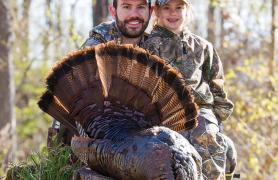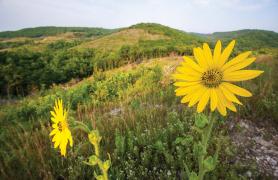Scientists monitor nests to study the health of birds and changes to the landscape
I remember the day I learned that finding bird nests for research studies was a job.
“Wait — what?!” I asked, incredulous. “Let me get this straight, I walk around in the woods all day and follow bird clues to find nests?”
It’s true — these jobs exist around the world. For my first bird field job, I was charged with finding nests of Acadian flycatchers in the forests of central Missouri. We followed the small gray birds around the forest, hoping they would lead us to their nests. We looked closely with binoculars to see if their beaks held grass (a sign of nest-building behavior) or were crammed full of insects (a sign they were feeding nestlings).
I felt like I’d been let in on a secret. Each nest that I found seemed like a hidden treasure as I recorded its success or failure over the following days or weeks. A nest was deemed successful if young survived from eggs to fledging or left the nest. Conversely, a nest failed if the eggs or nestlings did not make it to fledging, most often due to being eaten by a predator or destroyed by a storm or other weather.
Have you ever spotted a nest in a tree or shrub in your yard and wondered what kind of bird built it? Did you watch the nest for a while, waiting for the bird to return?
Maybe you’ve seen a woodpecker fly into a tree hole or flushed a hen turkey off of her eggs. If you’ve ever watched a bird build a nest, noticed a bird sitting on a nest for a week or two, or seen one poking fat caterpillars inside a nest to squawking nestlings, then you’ve monitored a nest like an avian ecologist, or bird scientist.
What Do Birds Tell Us?
Birds are not only beautiful and fun to watch, their activities also give scientists clues about the habitats they use. Most birds need three basic things for survival — food, water, and cover, or places to hide or find shelter. During the breeding season, they also need nesting sites — shrubs if they nest in thick, scrubby areas; large trees if they nest in the canopy or tree cavities; or a wetland with just the right amount of vegetation to tuck their nests among the cattails. Birds have the ability to quickly evaluate an area for their basic needs. If they don’t find the resources they need in an area, they can fly to find them somewhere else.
The power of flight allows birds to travel long distances to search for habitat that suits their needs relatively quickly. Most mammals, reptiles, and amphibians are confined to the ground and do not have that ability or aerial perspective to assess the area. Birds’ quick responses to environmental change can alert scientists and managers to changes in local habitat quality.
Habitat Selection
The landscape around birds is constantly changing. Managers remove trees for harvest to make way for development or to improve and restore grassland habitat. Swampy wetland areas can be drained, or an old farm can be reclaimed and restored to native habitat.
Different birds live in all of these types of habitat, so they must constantly adapt to changes around them and figure out what areas provide their basic needs.
For example, if a land manager or landowner has an overgrown forested area that historically was an open savanna and she wants the land restored, she will remove some trees to open the canopy and use prescribed fire every few years. Tree removal and fire are management tools that maintain a lush vegetative layer so more sunlight reaches the ground. The vegetation on the ground creates food and nesting sites for ground-nesting and shrub-nesting birds, while still maintaining habitat for tree-nesting birds. If a biologist is interested in the responses of wildlife, like birds, to this management, she can count birds or monitor their nests before and after the changes to gauge the impact on the bird community. If the bird counts show bird populations appear to increase or decrease, this can help the land manager determine whether the management is helping or hurting different species. Also, by creating savanna habitat from overgrown forest, managers give birds like prairie warblers or red-headed woodpeckers, species that would not use an overgrown forested area, a type of habitat they can use. Scientists and managers use monitoring to track birds’ responses to these land-use changes.
Scientists can also monitor bird nests to learn about the quality of a habitat. If a high proportion of bird nests in an area survive and produce lots of young, it can mean the parents are able to find better resources such as food, water, and healthy vegetation and nesting sites. Conversely, if many of the nests produce few fledglings and survival is low, that could be a sign to scientists and land managers that the area’s resources may not be as healthy as they could be.
How to Find an American Robin Nest
Nest searching is not an activity for those with a short attention span, but if you’ve followed my story this far, you might have what it takes. Patience is key. There are generally two ways to find a nest — by watching the parents and by looking in the spots where the bird normally nests. When robins build nests, they collect mud, grass, and some sticks. If you see a robin picking up mud or grass and flying immediately up to a tree, see if it goes to a nest. Look in the trees in your yard. Typically, robins nest near clumps of leaves in the top half of medium-to-large trees. If you normally see robins in your neighborhood or yard, there’s a good chance you may spot a nest.
Nest Etiquette
You can look for robin nests in your yard, but always be careful not to bother the parents, nestlings, or the nests in any way. This could change the parent’s behavior and may draw a potential predator’s attention to the nest. Blue jays and American crows will eat bird eggs or the nestlings of smaller birds. They are smart birds that can watch behaviors to lead them to a nest, so always view nests from a distance. Generally, birds are aware of their surroundings and on the lookout for potential threats or predators, especially when they are nesting, so you don’t want to be the reason that their nest fails. The breeding season is a very important time of year for birds, and a human walking around their nest may not be a regular occurrence, so be aware of the parents’ reactions.
Birds may stop their nest-building, feeding, or other nesting behaviors if you are too close to the nest. If the parents squawk at you, call over and over, or stop what they’re doing and watch you closely from a perch, move back to a distance that lets them calm down and stop calling. If you stay near the nest, the parents see you as a threat and won’t want to reveal where the nest is by sitting on their eggs or feeding nestlings. Sometimes the distance you have to move back may seem far, but that’s where binoculars come in handy. Binoculars allow you to view a bird’s nest from a distance without disturbing the adults or altering their parental care or behavior.
If you happen to find other nests closer to the ground in your yard or on your property, don’t move branches out of the way to see into a nest.
Even small changes to the bird’s nesting site may make the area more visible to a predator that may be looking for eggs or nestlings to eat. Moving branches or breaking a twig or two around the nest may not seem like a big deal to us, but the birds chose that nesting location for a reason.
Take Notes
As long as you keep a respectful distance, nest monitoring can be fun for adults and children alike. Just like humans are in the womb for about 40 weeks, each bird species spends a specific amount of time in the egg before hatching and in the nest as nestlings before flying. Some birds, like ducks and geese, are ready to leave the nest right when they hatch, but songbirds, like robins, are blind and naked when they hatch, and very helpless. Robins spend 12–14 days in the egg before hatching, and another 14–16 days in the nest before flying.
Make a monitoring calendar and write down when you see activity at the nest — building, incubating, or feeding.
Record if the female or male came to the nest. Male robins have darker heads than the paler females. Note how many nestlings you can see when they are big enough to poke their heads out of the nest, and try to guess what day they will fledge.
Birds Are Awesome
Nests and the breeding season are fascinating. Open-cup nesting birds like robins use their beaks to craft a perfectly circular nest by pasting together grass or twigs with spiderwebs or mud. Through the breeding season, birds throw every ounce of their energy into producing young, even if it means sacrificing their own health. They incubate eggs for long stretches of time. Once the eggs hatch, parents search for food to feed impatient nestlings, flying back and forth to the nest nonstop from sunrise to sunset. Not to mention having to defend the nest from predators and keep it clean and free of the nestlings’ waste. It’s always something special to watch a nest — just one tiny piece of a big, intricate network of nature happening all around us, in all habitats, across the globe.
Want to Monitor Nests for Science?
NestWatch is a volunteer nest-monitoring program by the Cornell Lab of Ornithology. Participants can keep tabs on nests in their yard or on their property and send in the data. The program has a strict Code of Conduct about being respectful of birds’ nests and a quiz that you must pass before getting started. To sign up, visit nestwatch.org.
Nest Diversity
The best part about birds is their diversity, and this applies to their nests, too.
Nests are built in an open cup, in a cavity like a tree hole or birdhouse, a scrape in sand on a beach, or a hanging basket weaved with their beak, to name just a few. Most birds in Missouri build an open-cup nest, nest in tree cavities, or nest on the ground. These nests were all found as part of research studies in Missouri.




























Also In This Issue


And More...
This Issue's Staff
Art Director - Cliff White
Associate Editor - Bonnie Chasteen
Staff Writer - Heather Feeler
Staff Writer - Kristie Hilgedick
Staff Writer - Joe Jerek
Photographer - Noppadol Paothong
Photographer - David Stonner
Designer - Les Fortenberry
Designer - Marci Porter
Designer - Stephanie Thurber
Circulation - Laura Scheuler






















